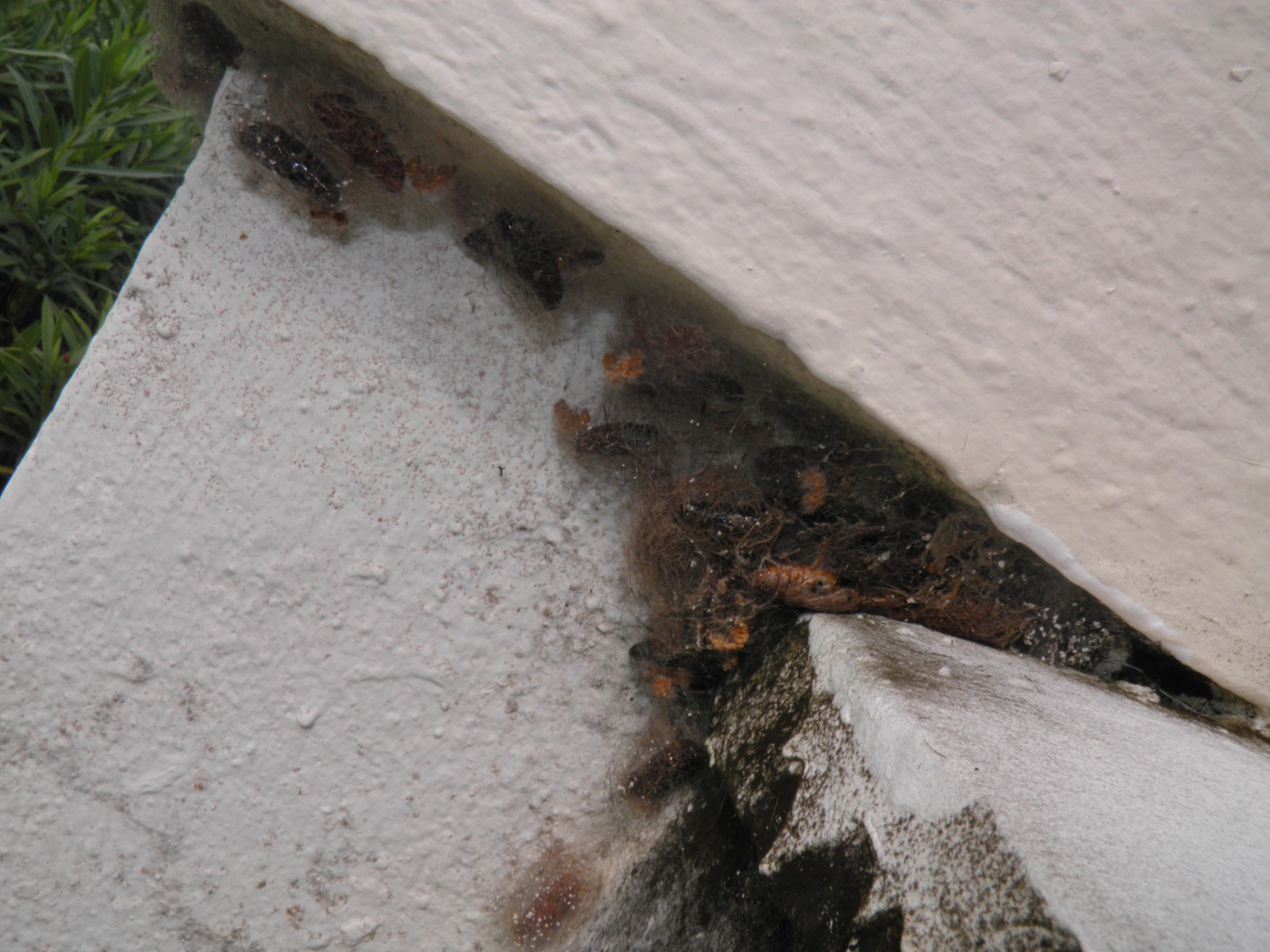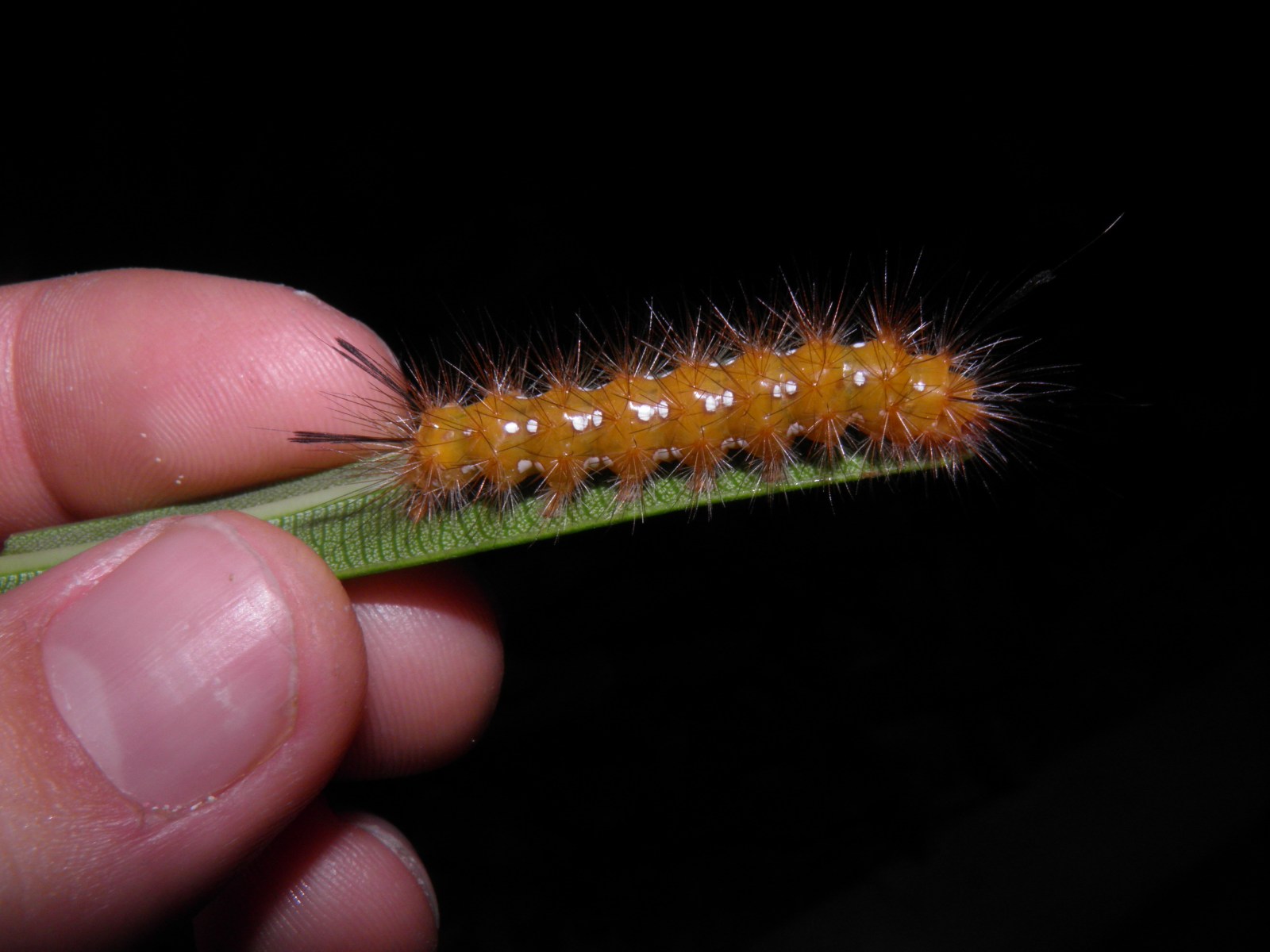Now, don’t get confused. Because there is also a “spotted oleander moth” aka the “polka dot wasp moth” that refers to the species Syntomeida epilais! It is a relative of Empyreuma pugione, the “spotted oleander caterpillar”. Confusing, because the adult of Empyreuma pugione is not spotted at all – it refers to their spotted larvae (spotted CATERPILLAR). Are you following me yet? This is why I prefer scientific names.
Empyreuma pugione is a beautiful tiger moth from the carribean, but it can also be found in Florida. Their host plant is oleander (Nerium oleander). The moths specialise on this plant and sequester the toxic substances from them.
 The adult of Empyreuma pugione
The adult of Empyreuma pugione
- Difficulty rating: Moderate (Not so hard to breed, but you will need oleander)
- Rearing difficulty: 5/10 (From egg to pupa)
- Pairing difficulty: 6.5/10 (Archieving copulations)
- Host plants: Nerium oleander
- Natural range: The Carribean islands and Florida
- Polyphagous: No (specialist on oleander)
- Generations: Multivoltine (continuously brooded)
- Family: Erebidae (Arctiidae) – tiger moths
- Pupation: Cocoon (silk encasing)
- Prefered climate: Warm and humid
- Special notes: These moths are specialists on oleander – a very toxic plant – and have evolved to be able to feed on this plant despite is toxicity. In fact, they sequester some of the toxic compounds of this plant, making themselves toxic in the process, an effective defense mechanism against predators. The moths are dayflying and need to be fed aswell as have acces to (day)light
- Estimated wingspan: 38 – 47 mm (medium)
- Binomial name: Empyreuma pugione (Linnaeus, 1767)
In the Carribean, I have observed a lot of Empyreuma pugione – they seemed to be a rather common “pest” on oleander bushes. Upon observing them, I had taken it upon myself to bring some livestock back to Europe.
Empyreuma pugione is a oleander (Nerium oleander) feeding specialist that is continuously brooded – in the wild, all life stages can be observed at the same time. The moths are dayflying and can be spotted on many kinds of flowers during the day, and in the vincinity of oleander.
 The spotted caterpillar is what gave the common name to this species
The spotted caterpillar is what gave the common name to this species
Empyreuma pugione can easily be reared in captivity, both in plastic boxes or in bottled host plant. They are less inclined to leave their host plants as many other Arctiidae, which makes bottling them an option. If touched or disturbed, the larvae will twitch heavily and run away at high speeds or drop themselves to the floor. So please note that they can be nervous escape artists!
The caterpillars are fully grown in about a month or longer (depends on temperature aswell). They tend to seek out the same spots to cocoon, perhaps because all of them are attracted to the same sheltered spots, or perhaps because this is a form of communal behaviour. In Punta Cana, many cocoons can be found spun together on walls and gates.
 Cocoon mass of Empyreuma pugione
Cocoon mass of Empyreuma pugione
Note that the hairs of these cocoons may be irritating to people who are sensitive to them. The moth can be expected to emerge in just a few weeks. The day active moths want to be fed and like to recieve a little bit of sunlight (unusual for moths).
 Empyreuma pugione raised in captivity
Empyreuma pugione raised in captivity
All in all, Empyreuma pugione is a beautiful moth that can easily be bred, as long as they can be given the correct lightning and food as adults. The red wings of the moth look similar to many Pompilidae wasps, perhaps a form of mimicry. Either that or an aposematic warning that signals their toxicity to predators.
 Empyreuma pugione adult resting in captivity in the Netherlands
Empyreuma pugione adult resting in captivity in the Netherlands
It is unknown if the larvae accept anything else than oleander, but I would not recommend substitutes due to their highly specialised nature. Good luck!
 Cocoon mass of Empyreuma pugione
Cocoon mass of Empyreuma pugione
Thank you for reading my article. This is the end of this page. Below you will find some useful links to help you navigate my website better or help you find more information that you need about moths and butterflies.
Dear reader – thank you very much for visiting! Your readership is much appreciated. Are you perhaps…. (see below)
-
-
- Not done browsing yet? Then click here to return to the homepage (HOMEPAGE)
- Looking for a specific species? Then click here to see the full species list (FULL SPECIES LIST)
- Looking for general (breeding)guides and information? Then click here to see the general information (GENERAL INFORMATION)
- Interested in a certain family? Then click here to see all featured Lepidoptera families (FAMILIES)
-
Citations: Coppens, B. (2019); Written by Bart Coppens; based on a real life breeding experience [for citations in literature and publications]
Was this information helpful to you? Then please consider contributing here (more information) to keep this information free and support the future of this website. This website is completely free to use, and crowdfunded. Contributions can be made via paypal, patreon, and several other ways.
All the funds I raise online will be invested in the website; in the form of new caresheets, but also rewriting and updating the old caresheets (some are scheduled to be rewritten), my educational websites, Youtube, breeding projects, the study of moths andconservation programs.
Donate button (Liberapay; credit card and VISA accepted)
Donate button (PayPal)
![]()
Become a member of my Patreon (Patreon)
![]()
Find me on YouTube

Find me on Instagram
![]()
Join the Discord server: Click here
Join the Whatsapp server: Click here
Buy insect cocoons: Click here
Facebook: Click here

